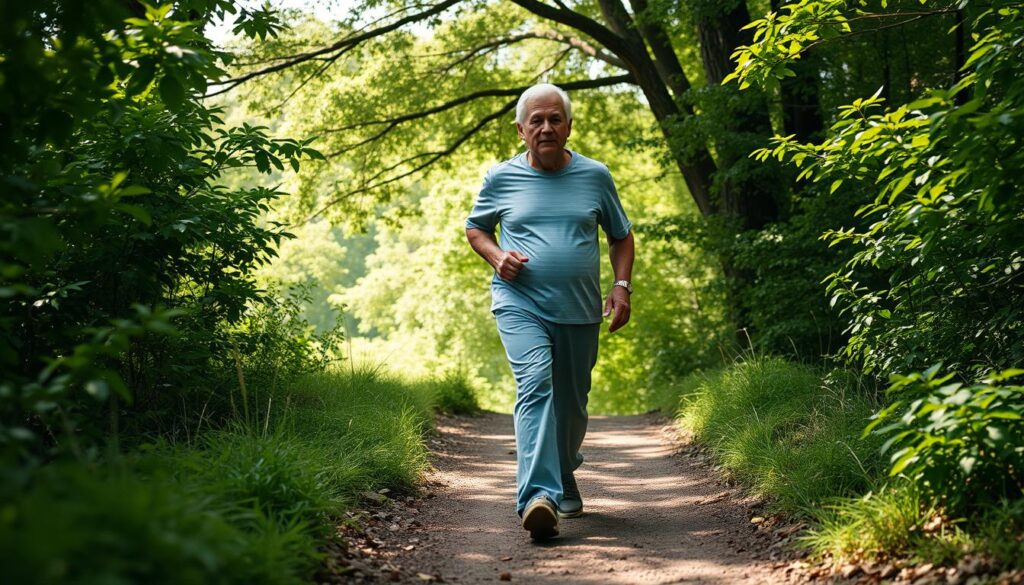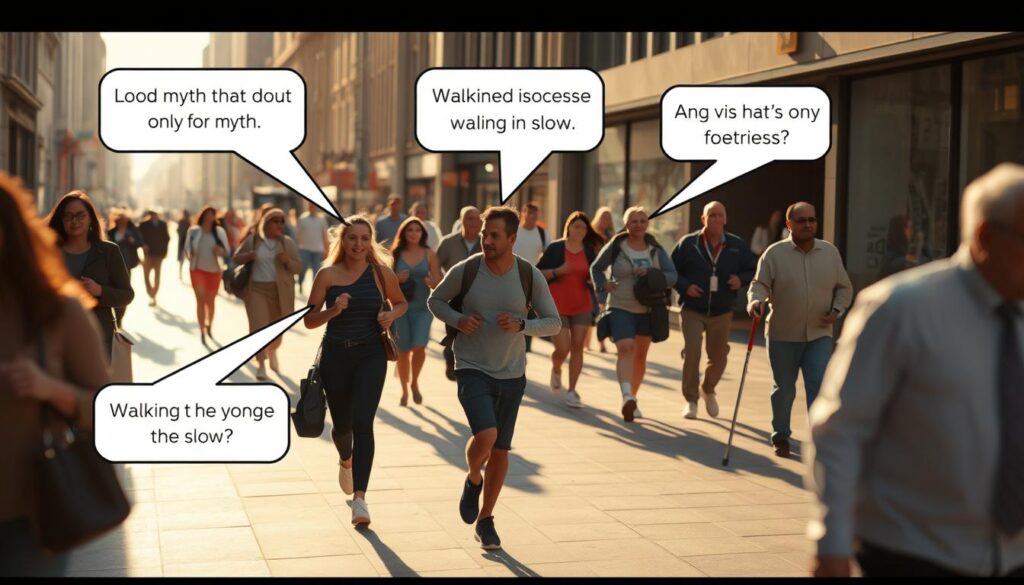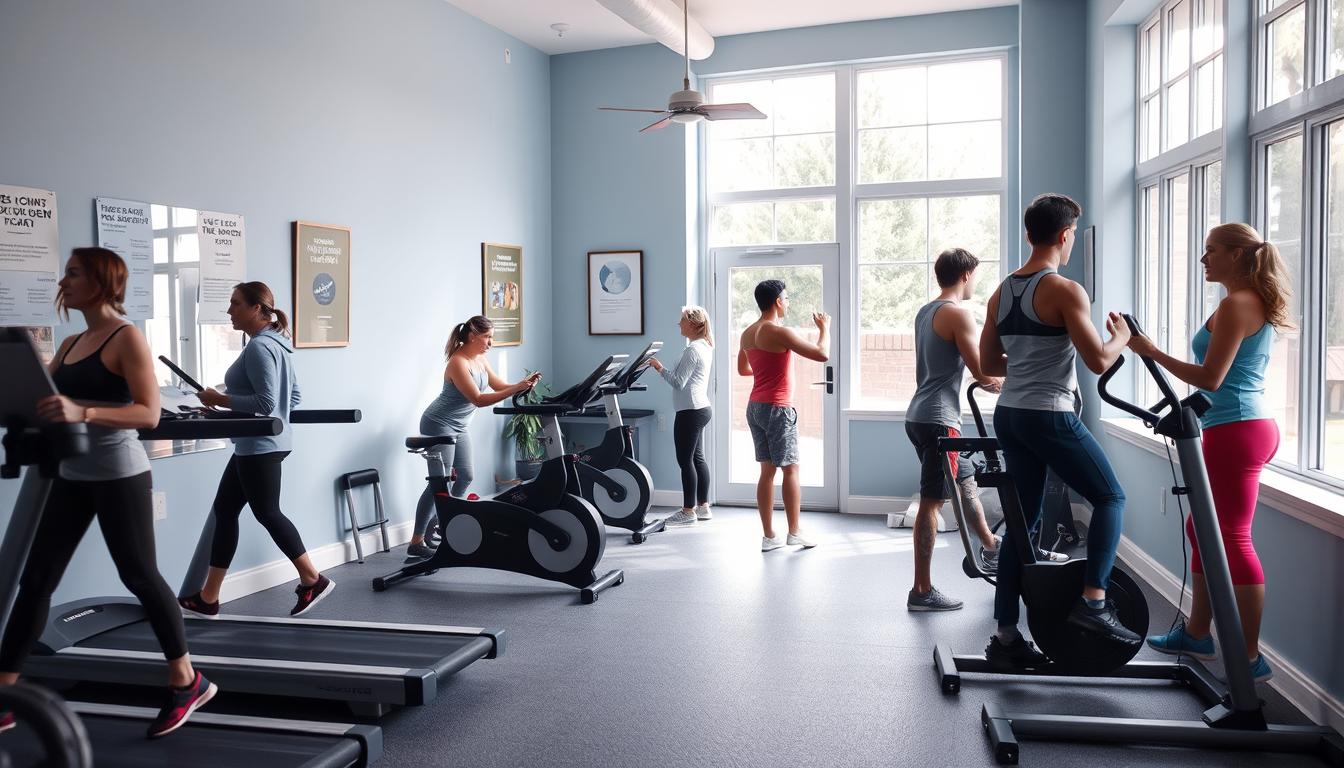I’ve always believed that the simplest habits often bring the most profound changes. One of those habits is walking. It’s something I’ve incorporated into my daily routine, and the results have been transformative. Walking is more than just a way to get from one place to another—it’s a powerful tool for improving your overall well-being.
What makes walking so special is its accessibility. You don’t need special equipment or a gym membership. All you need is a pair of comfortable shoes and a bit of time. Whether it’s a brisk stroll in the park or a quick walk around the block, this low-impact activity can do wonders for your body and mind.
From boosting heart health to clearing mental fog, walking offers a range of advantages. It’s a cost-effective way to stay active and fit, and it’s something almost anyone can do. In this article, we’ll explore how this simple activity can make a big difference in your life.
Key Takeaways
- Walking is an easy and accessible form of exercise.
- It improves both physical and mental health.
- Regular walking can enhance heart health and burn calories.
- It’s a low-risk activity suitable for almost everyone.
- Incorporating walking into your routine can boost overall well-being.
Introduction: Why Walking Matters to Me
It all started with a simple decision to move more. I was looking for an exercise that fit into my busy schedule and didn’t require expensive equipment. Walking seemed like the perfect solution. At first, it felt like a small step, but over time, it became a cornerstone of my daily routine.
My Journey to Embracing Walking
When I first started, I faced challenges. Finding time was tough, and I often felt too tired to take that first step. But I persisted. Gradually, I noticed improvements in my energy levels and mood. What began as a 10-minute stroll turned into a 30-minute daily habit.
Research supports my experience. A study found that walking is one of the safest forms of physical activity, with a low risk of injury compared to high-intensity workouts. This made me feel confident in sticking with it, even on days when motivation was low.
Walking’s simplicity is its greatest strength. You don’t need a gym membership or special gear—just a pair of comfortable shoes. It’s an accessible option for people of all fitness levels, and it’s easy to incorporate into your day.
Here’s a quick comparison of walking with other forms of exercise:
| Activity | Risk Level | Accessibility | Time Commitment |
|---|---|---|---|
| Walking | Low | High | Flexible |
| Running | Moderate | Medium | 30+ minutes |
| Weightlifting | High | Low | 45+ minutes |
My personal observations align with what science tells us. Walking is a gentle yet effective way to stay active. It’s a habit I’ve come to rely on, and it’s one I’m excited to share with others.
Benefits of Walking for Health
Science continues to reveal how small changes in daily habits can lead to significant health improvements. One of the most accessible and effective habits is walking. Research consistently shows that this simple activity can lower the risk of chronic disease, boost immune function, and enhance overall well-being.
Evidence and Research Highlights
Studies have found that regular walking can reduce the risk of heart disease, stroke, and type 2 diabetes. For example, a 2021 study showed that individuals who took 7,000 steps daily had a lower mortality rate. This highlights how even moderate activity can make a big difference.
Walking also supports immune health. Research indicates that it increases the number of immune cells, helping the body fight infections more effectively. This is especially important for maintaining long-term health and resilience.
Here are some key findings from recent studies:
- Walking 8,200 steps daily reduces the risk of obesity, hypertension, and diabetes.
- Post-menopausal women who walked 1 to 2 miles a day lowered their blood pressure by nearly 11 points.
- Regular walkers have a 30% lower risk of cardiovascular events compared to inactive individuals.
These findings underscore the broader implications of walking for everyday health. It’s not just about physical fitness—it’s about building a stronger, healthier body that can resist disease and thrive.
Incorporating a daily walk into your routine is a simple yet powerful way to invest in your health. The evidence is clear: small steps can lead to big changes.
Walking for Cardiovascular Health
Heart health is something I take seriously, and walking has been a game-changer for me. It’s a simple activity that has made a big difference in how my heart functions. Over time, I’ve noticed improvements in my endurance and overall cardiovascular system.
⏳ Get Your Energy Back with Discount!

Walking strengthens the heart muscle, making it more efficient at pumping blood. This reduces the strain on the heart and lowers the risk of heart disease. Studies show that even a moderate pace can lead to significant improvements in heart function.
Boosting Heart Function
Regular walking increases cardiovascular endurance. It helps the heart work more efficiently, which is crucial for long-term health. I’ve experienced this firsthand—my energy levels have improved, and I feel less fatigued during daily activities.
Research supports this. A study found that walking 30 minutes a day, five times a week, can reduce the risk of coronary heart disease by 19%. This highlights the benefit of consistent, moderate activity.
Reducing Blood Pressure
Walking also plays a key role in managing blood pressure. I’ve noticed that my blood pressure readings have become more stable since I started walking regularly. This aligns with studies showing that walking can lower systolic and diastolic blood pressure.
For example, postmenopausal women who walked 1 to 2 miles daily saw an 11-point drop in blood pressure. This demonstrates how small changes, like a brisk walk, can lead to significant health improvements.
| Activity | Impact on Heart Health | Time Commitment |
|---|---|---|
| Walking | Strengthens heart, lowers blood pressure | 30 minutes/day |
| Running | Improves cardiovascular endurance | 45 minutes/day |
| Cycling | Enhances heart function | 60 minutes/day |
Walking is a low-impact, accessible way to improve heart health. It’s a habit I’ve come to rely on, and the results speak for themselves. Whether it’s a short stroll or a brisk walk, every step counts toward a healthier heart.
Walking for Weight Management
Walking has become my go-to activity for managing weight and staying energized. It’s a simple, low-impact way to burn calories without feeling overwhelmed. Over time, I’ve noticed how consistent walks help me maintain a healthy weight while keeping my energy levels steady.
Burning Calories and Maintaining Energy
One of the reasons I love walking is its efficiency in burning calories. A 2021 study found that walking just one mile can burn about 100 calories. This makes it an excellent choice for anyone looking to manage their weight without intense workouts.
Regular walks also help regulate energy levels. I’ve found that a brisk walk in the morning or after lunch keeps me alert and focused throughout the day. Research supports this, showing that moderate activity like walking can improve energy balance and reduce fatigue.
For women and individuals of different ages, walking is a flexible option. Whether you’re in your 30s or 60s, adjusting your pace and duration can make it work for your fitness level. It’s an accessible way to stay active and support long-term weight management.
Here’s a quick look at how walking compares to other activities:
| Activity | Calories Burned (per mile) | Accessibility |
|---|---|---|
| Walking | 100 | High |
| Running | 150 | Medium |
| Cycling | 50 | Medium |
Walking fits seamlessly into my daily routine. It’s a habit I’ve come to rely on for both physical and mental well-being. Whether it’s a short stroll or a longer walk, every step contributes to a healthier, more balanced lifestyle.
Regulating Blood Sugar Through Walking
Managing blood sugar levels has always been a priority for me, and walking has become a key part of that effort. One of the most effective strategies I’ve adopted is taking short walks after meals. This simple habit has helped me stabilize my glucose levels and feel more in control of my health.
Post-Meal Walks for Glucose Control
Research shows that even a five-minute walk after eating can significantly lower blood sugar levels. I’ve found that walking within 60 to 90 minutes of a meal helps moderate glucose spikes. This practice is especially beneficial for anyone at risk of type 2 diabetes.
Studies indicate that post-meal walks improve insulin sensitivity and reduce extreme blood sugar fluctuations. For example, participants who walked after meals experienced more gradual changes in glucose levels. This consistency makes walking a practical tool for long-term metabolic health.
Here’s how I’ve incorporated post-meal walks into my routine:
- I take a 10-minute walk after breakfast and dinner.
- I adjust the pace based on how I feel—sometimes brisk, sometimes leisurely.
- I use these walks as a time to clear my mind and enjoy the outdoors.
Walking after meals also supports overall cardiovascular health. By improving blood flow and reducing glucose levels, it lowers the risk of heart-related issues. This dual benefit makes it a valuable habit for anyone looking to enhance their well-being.
For those new to this practice, start with a short walk and gradually increase the duration. Even a few minutes can make a difference. Consistency is key—making it a daily habit ensures long-term benefits for both blood sugar and heart health.
Easing Joint Pain with a Daily Walk
Joint pain used to slow me down, but walking changed everything. It’s a simple, low-impact activity that has helped me manage discomfort and improve mobility. Over time, I’ve noticed how consistent walks keep my joints lubricated and my muscles strong, reducing aches and stiffness.
🌟 Boost Your Well-Being Today!

Protecting and Lubricating Joints
Walking promotes better blood flow, which delivers essential nutrients to joint tissues. This helps keep joints lubricated and reduces friction. Research shows that physical activity like walking compresses and releases cartilage, aiding in the circulation of synovial fluid. This natural lubrication is key to easing pain and improving flexibility.
Strengthening the muscles around joints is another benefit. Stronger muscles provide better support, reducing pressure on joints. For example, stronger leg muscles help distribute weight more evenly, which can reduce risk of joint degeneration. Studies have found that regular walkers are less likely to develop mobility issues compared to those who are inactive.
Here’s how I’ve incorporated walking into my routine to manage joint pain:
- Start with short walks and gradually increase duration as comfort improves.
- Focus on a steady pace—too fast can strain joints, too slow may not provide enough benefit.
- Use supportive shoes to minimize impact and improve posture.
For those with arthritis, walking can be particularly beneficial. A study involving seniors found that one hour of brisk walking per week lowered the risk of mobility disability by 85%. This highlights how even moderate activity can make a significant difference.
Walking has become a cornerstone of my joint health routine. It’s a habit I rely on to stay active and pain-free. Whether it’s a short stroll or a longer walk, every step contributes to stronger joints and a healthier body.
Mental and Emotional Boosts from Walking
I discovered that walking does more than just move my body—it transforms my mind. It’s become my go-to activity for lifting my mood and sparking creativity. Even a short walk can make a big difference, and I’ve experienced this firsthand.
Lifting My Mood
Walking has a natural way of lifting my spirits. Research shows that physical activity triggers the release of endorphins, which are known as “feel-good” hormones. I’ve noticed that even a 10-minute walk can turn a bad day around.
Since incorporating walking into my routine, I’ve felt more balanced and less stressed. Studies back this up, suggesting that regular walks reduce anxiety and depression. It’s a simple yet powerful way to improve mental wellness.
Enhancing Creative Thinking
Walking has also become my secret weapon for creativity. I’ve had some of my best ideas while strolling outdoors. Research supports this, showing that even a brief walk can enhance creative thinking.
For example, a study found that participants who walked for just 10 minutes generated more innovative ideas compared to those who sat. This aligns with my experience—walking clears mental fog and sparks fresh perspectives.
Here’s how I’ve benefited from walking:
- Improved mood and reduced stress levels.
- Enhanced creativity and problem-solving skills.
- Increased energy and mental clarity throughout the day.
Walking isn’t just a physical activity—it’s a mental reset button. Whether it’s a quick stroll or a longer walk, every step contributes to a healthier, happier mind.
Strengthening Bones and Muscles with Every Step
Taking steps to strengthen my body has been a game-changer for my overall health. Walking isn’t just about movement—it’s about building resilience. Over time, I’ve noticed how this simple activity has improved my bone density and muscle tone, making me feel stronger and more confident.
One of the most significant benefits is the reduction in fall and fracture risks. Studies show that regular walking can lower the chance of hip fractures by up to 25%. This is especially important as we age, when bones naturally become more fragile.
Toning Legs and Core
Walking engages major muscle groups, particularly in the legs and core. I’ve found that focusing on posture during my walks has strengthened my core stability. This not only improves balance but also reduces strain on my back.
Research supports this. A Harvard study found that fast walking increases the force on hip bones by 30%, enhancing bone density. This makes walking an excellent weight-bearing exercise for long-term bone health.
Here’s how I’ve tailored my walks for maximum benefit:
- Incorporate varied terrain like hills or uneven paths to challenge muscles.
- Focus on maintaining an upright posture to engage the core.
- Gradually increase duration and intensity over time.
Walking also plays a role in reducing the risk of heart disease. Regular physical activity strengthens the heart and improves circulation, which is crucial for a healthy life. Studies show that even moderate walking can lower the risk of cardiovascular events by 30%.
Consistency is key. Over time, I’ve seen how small, daily efforts add up to significant improvements. Whether it’s a short stroll or a brisk walk, every step contributes to stronger bones, toned muscles, and a healthier body.
Creating a Personalized Walking Routine
Building a walking routine that fits my life has been one of the most rewarding changes I’ve made. It’s not just about moving more—it’s about creating a system that works for my schedule and goals. Here’s how I designed a routine that’s both effective and sustainable.
Setting Achievable Daily Goals
I started by assessing my current fitness level. For me, this meant tracking how long I could walk without feeling tired. I began with just 10 minutes a day and gradually increased the duration each week. This approach helped me build endurance without feeling overwhelmed.
Tracking progress was key. I used a simple journal to note my daily steps and how I felt afterward. Over time, I could see improvements in my stamina and mood. This motivated me to keep going and set new goals.
Gradual Increases in Intensity and Duration
Once I felt comfortable with my routine, I started to increase the intensity. I added short bursts of brisk walking or incorporated hills into my route. This not only challenged my body but also kept the routine interesting.
Here’s a breakdown of how I structured my routine:
| Week | Duration | Intensity |
|---|---|---|
| 1 | 10 minutes/day | Leisurely pace |
| 2 | 15 minutes/day | Moderate pace |
| 3 | 20 minutes/day | Brisk pace |
Integrating Walking into a Balanced Health System
Walking became a cornerstone of my overall health system. I paired it with other healthy habits, like staying hydrated and eating nutritious meals. This holistic approach made it easier to stick to my routine and see long-term results.
Here are my top tips for creating a personalized walking routine:
- Start small and gradually increase duration and intensity.
- Track progress weekly to stay motivated.
- Incorporate variety to keep the routine engaging.
- Pair walking with other healthy habits for a balanced system.
By following these steps, I’ve built a walking routine that fits seamlessly into my life. It’s a simple yet powerful way to stay active and healthy.
Essential Gear and Safety Tips for Walking
Proper gear and safety practices have transformed my walking routine into a seamless and enjoyable experience. Whether I’m strolling through the park or navigating city streets, having the right equipment and precautions in place ensures I stay comfortable and protected.
Choosing the Right Shoes
Investing in supportive shoes has been a game-changer for me. Proper footwear prevents injuries and enhances comfort, especially during longer walks. I’ve learned that shoes with good arch support and cushioning reduce strain on my body and help maintain an even weight distribution.
Here’s a quick comparison of shoe types to consider:
| Type | Best For | Key Features |
|---|---|---|
| Walking Shoes | Daily walks | Lightweight, cushioned soles |
| Trail Shoes | Uneven terrain | Durable, grippy soles |
| Running Shoes | Brisk walking | Shock absorption, flexibility |
Experts recommend replacing walking shoes every 300 to 500 miles to ensure optimal support. This simple habit has helped me avoid discomfort and stay active.
Staying Safe on the Road
Safety is a priority, especially when walking in urban areas. I always wear reflective clothing during low-light conditions to stay visible. Carrying a water bottle keeps me hydrated, which is essential for maintaining energy and burning calories effectively.
Here are my top safety tips:
- Warm up with light stretches before starting your walk.
- Stick to well-lit paths and sidewalks to avoid hazards.
- Stay aware of your surroundings, especially in busy areas.
By following these practices, I’ve made walking a safe and rewarding part of my daily routine. Proper gear and precautions not only protect my body but also enhance my overall experience.
Increasing Your Walking Intensity Safely
Incorporating intervals into my walks has been a game-changer for my energy levels. It’s a simple way to boost intensity without overexerting myself. By alternating between brisk and moderate paces, I’ve noticed significant improvements in my fitness and stamina.
Research supports this approach. A study found that interval training can improve cardiovascular health and burn more calories than steady-paced walking. It’s also a great way to avoid pain or injury, as the body adapts gradually to the increased intensity.
How to Introduce Interval Training
Start with short bursts of brisk walking, followed by longer periods of moderate pacing. For example, walk briskly for 1 minute, then slow down for 3 minutes. Repeat this cycle for 20-30 minutes. Over time, you can increase the duration of the brisk intervals.
Here’s a sample plan to get started:
| Week | Brisk Interval | Moderate Interval |
|---|---|---|
| 1 | 1 minute | 3 minutes |
| 2 | 2 minutes | 3 minutes |
| 3 | 3 minutes | 2 minutes |
Benefits of Interval Walking
Interval walking not only boosts energy but also enhances physical performance. It’s particularly effective for improving endurance and burning calories. Studies show that this method can increase metabolic rate and improve overall fitness levels.
Personally, I’ve found that interval training lifts my mood and keeps me motivated. The variation in pace makes the routine more engaging, and I feel accomplished after each session.
Safety Measures
To avoid pain or strain, it’s important to warm up before starting intervals. Stretching and starting with shorter bursts can help the body adjust. Listen to your body—if you feel discomfort, reduce the intensity or duration of the brisk intervals.
Here are my top tips for safe interval walking:
- Start with shorter intervals and gradually increase intensity.
- Wear supportive shoes to minimize impact on joints.
- Stay hydrated and take breaks if needed.
By following these steps, I’ve made interval walking a safe and effective part of my routine. It’s a simple way to challenge myself and see real results.
Incorporating Walking into My Daily Life
Finding time for myself has always been a challenge, but walking has become my solution. It’s a simple habit that fits seamlessly into my busy schedule. By making small adjustments, I’ve been able to improve my overall well-being without feeling overwhelmed.

Adjusting My Schedule for Consistency
I started by identifying pockets of time in my day. For example, I now take a 10-minute walk during my lunch break. This not only helps me stretch my legs but also clears my mind for the afternoon. Consistency has been key to making this a lasting habit.
Here’s how I’ve structured my routine:
- Morning: A quick 15-minute walk around my neighborhood.
- Afternoon: A brisk walk during lunch or after meetings.
- Evening: A leisurely stroll to unwind before bed.
Research shows that breaking activity into shorter sessions can be just as effective as longer ones. This approach has helped me stay consistent and improve my physical health over time.
Overcoming Scheduling Obstacles
One of the biggest challenges was finding time in my busy area. To overcome this, I started parking farther from my office and taking the stairs instead of the elevator. These small changes added up, making it easier to incorporate walking into my day.
Here’s a comparison of how I’ve adjusted my routine:
| Before | After |
|---|---|
| Driving to work | Parking farther and walking |
| Using the elevator | Taking the stairs |
| Sedentary lunch breaks | Walking during lunch |
By making these adjustments, I’ve been able to improve my activity levels without disrupting my schedule. Walking has become a natural part of my daily life, and the benefits are undeniable.
Small, incremental changes can lead to significant long-term results. Whether it’s a short walk around your area or a brisk stroll during breaks, every step counts toward a healthier lifestyle.
Expert Advice on the Health Benefits of Walking
Learning from experts has deepened my appreciation for walking as a transformative habit. Their insights have not only validated my personal experience but also provided a roadmap for maximizing its impact. By combining their wisdom with my routine, I’ve unlocked new levels of well-being.
Insights from Leading Fitness Professionals
Denise Austin, a renowned fitness expert, emphasizes the simplicity of walking.
“Walking is the most accessible form of physical activity. It’s free, easy, and effective for people of all fitness levels,”
she says. Her advice resonates with me, especially when balancing a busy schedule.
Adam Mills, a certified trainer, highlights the measurable health benefits of walking.
“Regular walking improves cardiovascular health, boosts mood, and aids in weight management. It’s a low-risk activity with high rewards,”
he explains. This aligns with my experience of feeling more energized and focused after each walk.
Dr. Jampolis, a physician specializing in walking, shares research-backed insights.
“Walking reduces the risk of chronic diseases like diabetes and heart disease. It’s a powerful tool for long-term health,”
she notes. Her perspective has inspired me to prioritize consistency in my routine.
Applying Expert Guidance
Here’s how I’ve incorporated their advice into my daily life:
- Start with a 10-minute walk and gradually increase duration.
- Focus on posture to engage core muscles and improve balance.
- Use walking as a mental reset, especially during stressful days.
Research supports these practices. A researcher found that walking 7,000 steps daily can lower the risk of chronic diseases by 50%. This statistic motivates me to stay consistent, even on busy days.
By following expert guidance, I’ve transformed walking from a simple activity into a cornerstone of my health routine. Their insights have not only enhanced my physical well-being but also deepened my appreciation for this accessible form of physical activity.
Leveraging Technology to Track My Walking Progress
Technology has become my trusted companion in tracking my daily steps and progress. It’s amazing how tools like fitness trackers and apps have transformed the way I monitor my activity. These devices not only keep me accountable but also motivate me to stay consistent.
Using a pedometer or a smartphone app has made it easy to measure my steps per day. I’ve noticed that seeing my progress in real-time encourages me to push further. It’s like having a personal coach in my pocket, guiding me toward my goals.
Using Pedometers and Apps for Motivation
One of the biggest advantages of technology is its ability to provide instant feedback. For example, apps like Fitbit and MyFitnessPal track my steps, calories burned, and even my blood pressure. This data helps me understand the effect of my efforts and adjust my routine accordingly.
Here’s how I’ve benefited from using these tools:
- Increased accountability by setting daily step goals.
- Improved motivation through progress tracking and reminders.
- Enhanced understanding of how activity impacts my health metrics.
Research supports this. A study found that people who use fitness trackers are more likely to meet physical activity guidelines. This aligns with my experience—having data at my fingertips keeps me focused and motivated.
Here’s a comparison of popular tracking devices:
| Device | Features | Best For |
|---|---|---|
| Fitbit | Step tracking, heart rate monitoring | Daily activity tracking |
| Apple Watch | ECG, workout tracking | Comprehensive health monitoring |
| Garmin | GPS, advanced metrics | Outdoor activities |
By leveraging technology, I’ve made walking a more measurable and rewarding part of my routine. It’s a simple yet powerful way to stay active and healthy.
Common Myths and Facts About Walking
Walking is often misunderstood, but the facts reveal its true power. Many people underestimate its impact, believing it’s not enough to make a difference. However, research and personal experience have shown me how effective it can be when done consistently and correctly.

Debunking Misconceptions
One common myth is that walking isn’t a “real” workout. This couldn’t be further from the truth. Studies show that even moderate walking can improve cardiovascular health, boost mood, and support weight management. For example, walking 7,000 steps daily has been linked to a lower risk of chronic diseases.
Another misconception is that you need to hit 10,000 steps to see results. While this number is often cited, research indicates that benefits start at just 2,600 steps per day. Walking more increases these benefits, but even small increases in daily steps can make a difference.
Realizing True Health Benefits
Walking does more than just move your body—it enhances cellular function. Physical activity helps muscle cells absorb glucose, improving insulin sensitivity and reducing the risk of type 2 diabetes. This is why walking after meals can be particularly effective in managing blood sugar levels.
Here’s a quick look at the science:
- Walking 8,800 steps daily maximizes health benefits, including reduced mortality risk.
- Short walks after meals can lower blood sugar spikes more effectively than standing or sitting.
- Regular walking improves immune cell activity, helping the body fight infections.
My perspective on walking changed when I learned these facts. It’s not just about moving—it’s about how each step contributes to overall health. By debunking myths and focusing on the evidence, I’ve made walking a cornerstone of my routine.
Conclusion
Taking the first step toward a healthier lifestyle can feel daunting, but walking makes it simple and achievable. Throughout this article, I’ve shared how integrating a daily step routine has transformed my physical and mental well-being. Research and personal experience highlight its accessibility and effectiveness, from improving heart health to boosting mood.
Starting small is key. Set achievable goals, like a 10-minute walk, and gradually increase your pace or duration. Tracking progress with tools like fitness apps can keep you motivated and consistent. Remember, even a short brisk walking session can make a difference.
Walking isn’t just about movement—it’s about building a healthier, happier life. Take that first step today, and let each stride bring you closer to your goals. Your journey to better health starts now.








Comment on “Discover the Benefits of Walking for Health Tips”